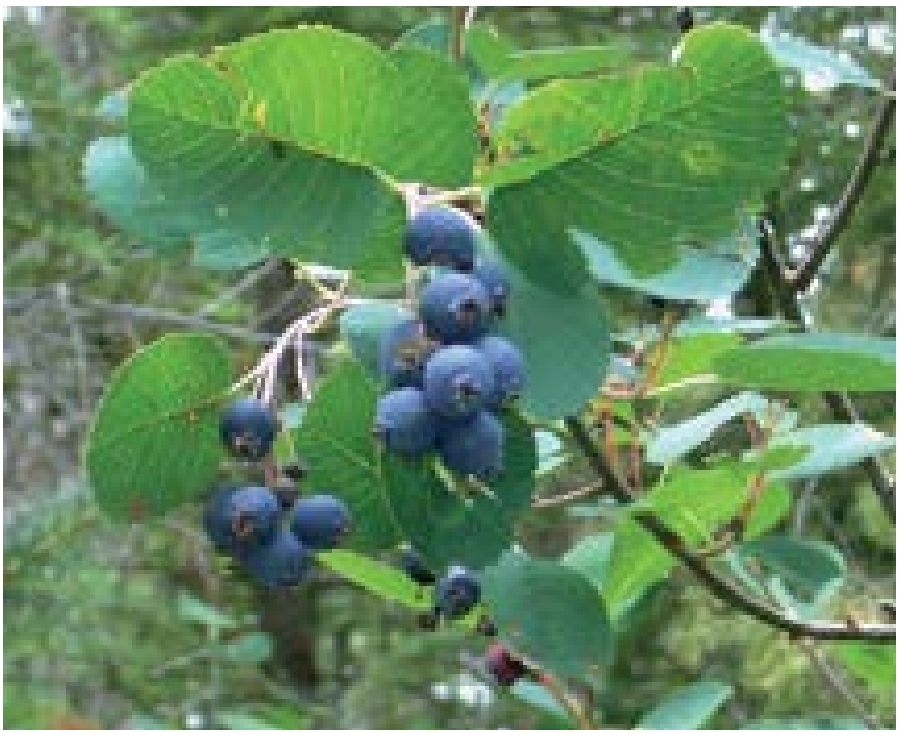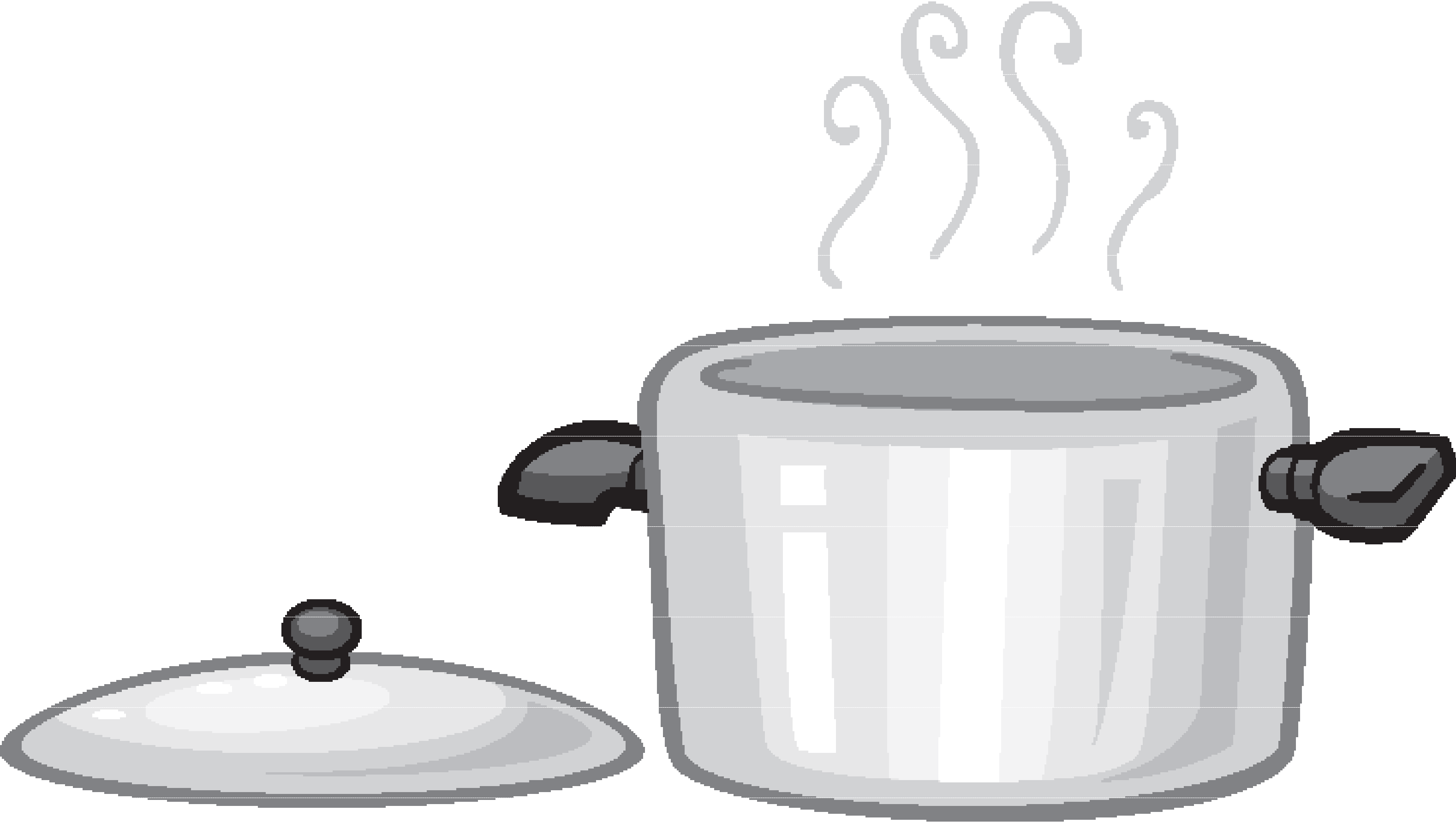Serviceberries
FNH-00122 View this publication in PDF form to print or download.

Serviceberry, also called Juneberry or Saskatoon berry, is a purple fruit from a shrub or tree 6 to 16 feet high, found in thickets or borders of woods. The berry is available in late fall in Southeast Alaska, the Gulf Coast of Alaska and throughout the Alaska Peninsula. Serviceberries are small, rounded, purple-black, edible and sweet. The berries have a pleasing, unique flavor and are high in iron and copper. Serviceberries can be eaten raw, cooked in puddings, pies and muffins, or used in combination with other berries as an extender. The berries can also be dried and used to replace raisins in recipes. Native Alaskans used them in soups, stews and pemmican.
Storage and Preservation
How to Clean and Store
Spread a clean, dry terry cloth towel over a slanted surface, such as a cutting board, with one end propped up a few inches above the other. Gently roll the berries down the towel; most of the debris and leaves will cling to the towel while the berries roll off. Fresh serviceberries should be stored covered in the refrigerator and will keep up to one week.
How to Freeze
To freeze serviceberries, arrange dry, fresh berries in one layer on a cookie sheet and place in the freezer. When frozen, transfer berries to freezer bags or containers. Frozen serviceberries stored in airtight containers below 0 degrees F will maintain good quality for up to two years.
How to Dry
Select firm, dry serviceberries. Dip berries in boiling water for a few seconds to crack skin. To sun dry, cover a flat tray with cheesecloth or light muslin. Spread the berries on the cloth and place the tray in the sun. Dry in the sun for two days, turning once or twice, then set the tray in a warm, dry place and let serviceberries stand until leathery to the touch. To dry berries in a dehydrator, spread on open screen and dry as for other berries, following directions for the dehydrator. Oven drying is possible, but very low heat (140 degrees F) must be used and the oven door must be left slightly open with a fan placed nearby so moisture can escape. Store in a cool dry place. Use as you would raisins. Dried serviceberries can be soaked in water for use in baking.
How to Extract Juice
Combine 11 cups of serviceberries and 1 cup water. Crush berries. Bring just to a boil and simmer 10 minutes. Strain through jelly bag or several layers of cheesecloth in a colander. Let the juice drip into a bowl. For clear juice, do not twist or press jelly bag or cheesecloth. For long-term storage, the juice should be frozen or canned.
Yield: 5½ cups
Hot pack for juice
Sterilize canning jars. Heat juice, stirring occasionally, until it begins to boil. Pour into hot jars, leaving ¼ inch headspace. Wipe jar rims. Adjust lids. Process in a boiling water canner.
- Quarts or smaller: 5 minutes
How to Prepare Puree
Put 4 cups of serviceberries in a blender and blend until the consistency of thick puree. For long-term storage, the puree should be frozen.
To can, fill hot jars with hot puree, leaving ¼ inch headspace. Process quarts or pints in a boiling water bath for 15 minutes. Purees can be processed in a dial gauge pressure canner for 8 minutes at 6 pounds pressure or at 5 pounds pressure in a weighted gauge canner. For more information on pressure canning, contact your local Cooperative Extension Service office.
Yield: 2 cups
Recipes
Serviceberry Syrup
- 1 cup serviceberry juice
- 2 cups sugar
- 1 teaspoon lemon juice
Combine all ingredients in a saucepan and heat to 160 degrees F. Use a candy thermometer; do not boil. The syrup is ready to use over waffles, pancakes, hot biscuits, ice cream and other desserts. Syrup will keep up to six months in the refrigerator without crystalizing.
For long-term storage: Sterilize pint or half-pint canning jars and prepare lids. Immediately pour hot syrup into hot canning jars, leaving ¼ inch headspace. Wipe jar rims and adjust two-piece lids. Process 5 minutes in a boiling water canner.
Yield: 2 cups
Serviceberry Ketchup
- 2 cups serviceberries
- ¼ teaspoon ground allspice
- ⅓ cup chopped sweet onion
- ¼ teaspoon salt
- ⅛ teaspoon ground nutmeg
- ¼ cup balsamic vinegar
- 3 tablespoons water
- ¼ cup ketchup
- 3 tablespoons sugar
Combine all ingredients except water in a nonreactive saucepan (stainless steel, glass, enamelware or ceramic). Bring to a boil over medium heat. Reduce heat to low and simmer, stirring occasionally, for 15 minutes. Remove from heat and let cool for 15 minutes. Transfer mixture to a blender; add water. Puree mixture until smooth. Cover and refrigerate for up to one week. Serve with pork, lamb, chicken or grilled potatoes.
Yield: 1½ cups
Serviceberry Applesauce Fruit Leather
- 1 cup serviceberry puree
- 1 cup unsweetened applesauce
- 1 tablespoon honey or corn syrup
Combine serviceberry puree, applesauce and sweetener. Line a cookie sheet with plastic wrap. Spread puree mixture evenly about ¹⁄8 to ¼ inch thick over plastic, but do not push it completely to the sides of the cookie sheet. Oven dry at 140 degrees F for approximately 6 hours, leaving oven door slightly open so moisture can escape. If drying in a dehydrator, follow manufacturer’s directions for fruit leathers.
Yield: 1 sheet
- To sterilize canning jars, boil in water for 5 minutes.
- To prepare two-piece lids (rings and tops), wash, rinse set aside until ready to use. Follow manufacture’s directions for use.
- If less sugar is desired in recipes calling for pectin, be sure to use no-sugar-needed pectin and follow the instructions on the box.
- See later instructions on this page for how to use a boiling water canner.
Serviceberry Jam
- 4 cups serviceberries
- 2 oranges
- 1½ cups water
- ½ cup lemon juice
- 3 cups sugar
Put serviceberries through food chopper with a medium-fine blade. Juice the two oranges and put the peel through the food chopper. Combine berries, orange peel and water in a large saucepan; boil gently until fruit is tender. Add juice from oranges, lemon juice and sugar. Boil 20 minutes or until the desired consistency is reached. Pour hot jam into hot pint or half-pint jars, leaving ¼ inch headspace. Wipe jar rims and adjust two-piece lids. Process 15 minutes in a boiling water-bath canner.
Yield: 6 cups
Serviceberry Muffins
- 1½ cups all-purpose flour
- ½ cup sugar
- 2 teaspoons baking powder
- ½ teaspoon salt
- 1 egg
- ½ cup milk
- ¼ cup vegetable oil
- ¾ cup serviceberries
Lightly oil muffin pans. In a bowl, measure and mix together flour, sugar, baking powder and salt. In another bowl, beat egg; add milk and oil. Pour liquid ingredients into dry ingredients. Mix dry ingredients until just moistened, about 15 mixing strokes; batter should be lumpy. Fold in serviceberries. Fill muffin cups two-thirds full. Bake at 400 degrees F for 20 to 25 minutes or until golden brown. Immediately remove muffins from pans and cool on a wire rack.
Yield: 12 muffins
- Fill the canner halfway with water. Preheat water to a low boil. Place filled jars, fitted with lids, into the canner on the rack. Add more boiling water, if needed, so the water level is at least 1 inch above jar tops. Turn heat to its highest position until water boils vigorously. When the water boils, set a timer for the recommended processing time indicated in the recipe. Cover with the canner lid and lower heat setting to maintain a gentle boil throughout the processing time. Add more boiling water, if needed, to keep the water level above the jars.
- When the jars have been boiled for the recommended time, turn off the heat and remove the canner lid. Using a jar lifter, remove the jars and place them on a towel, leaving at least 1 inch of space between the jars during cooling.
- After cooling jars for 12 to 24 hours, remove the screw bands and test seals. Press the middle of the lid with a finger. If the lid springs up when finger is released, the lid is unsealed. If a lid fails to seal on a jar, remove the lid and check the jar-sealing surface for tiny nicks. If necessary, change the jar, add a new, properly prepared lid and reprocess within 24 hours using the same processing time. Alternately, adjust headspace to 1½ inches and freeze or store in the refrigerator and use within three days.
- If lids are tightly sealed on cooled jars, remove screw bands, wash the lid and jar
to remove food residue, then rinse and dry jars. Label and date the jars. Store
in a clean, cool, dark, dry place.

Serviceberry Pie
- 4 cups fresh serviceberries
- ¼ cup water
- 2 tablespoons lemon juice
- ¾ cup white sugar
- 3 tablespoons all-purpose flour
- 1 tablespoon butter
- pastry for a two-crust 9-inch pie
Preheat oven to 425 degrees F. In a large saucepan, simmer berries in ¼ cup water for 10 minutes. Stir in lemon juices. Combine sugar and flour in a medium bowl; stir into berry mixture. Pour mixture into pastry-lined 9-inch pie pan. Dot with butter. Place second crust on top of pie; seal and flute edges. Cut vents in top. Bake in preheated oven for 15 minutes. Reduce oven temperature to 350 degrees F and bake for an additional 35 to 45 minutes, or until golden brown.
Serviceberry Rhubarb Pie
- 4 cups fresh or frozen serviceberries
- 1 cup chopped rhubarb
- 1 tablespoon lemon juice
- ¾ cup sugar
- 3 tablespoon quick-cooking tapioca
- 1 teaspoon grated lemon peel
- 1 tablespoon butter
- pastry for a two-crust 9-inch pie
Preheat oven to 425 degrees F. Combine serviceberries and rhubarb and drizzle with lemon juice. Combine sugar, tapioca and lemon peel; toss with fruit. Line a pie pan with prepared pastry. Fill with fruit mixture. Dot with butter. Cover with remaining pastry; flute edges. Cut vents in pastry. Bake in preheated 425 degrees F oven for 10 minutes. Reduce temperature to 375 degrees F and bake 45 to 55 minutes longer or until pastry is golden and filling is bubbly.
UAF Cooperative Extension Service Resources
Jams and Jellies, FNH-00730
Canning Overview, FHN-00705
Using Alaska’s Wild Berries and Other Wild Edibles ($), FNH-00120
Fruit Leather, FNH-00228
Canning Acidic Foods: Fruits, FNH-00710
Remaking Soft Jams and Jellies, FNH-00731
Fruit Spreads: Butter, Honey, Sauce, Syrup, FNH-00732
Drying Fruits and Vegetables, FNH-00745
Recipes for Serviceberry Rhubarb Pie and Serviceberry Ketchup are used with permission from ATCO Blue Flame Kitchen, www.atcoblueflamekitchen.com. These recipes were not changed in any way and have been proofed for accuracy. Other recipes were originally printed in Collecting and Using Alaska’s Wild Berries and Other Wild Products, UAF Cooperative Extension publication FNH-00120.
Sarah R-P. Lewis, Extension Faculty, Health, Home and Family Development. Originally written by Roxie Rodgers Dinstel, Extension Faculty, Health, Home and Family Development, and Marci Johnson, former Program Assistant, Health, Home and Family Development.
Revised January 2022
